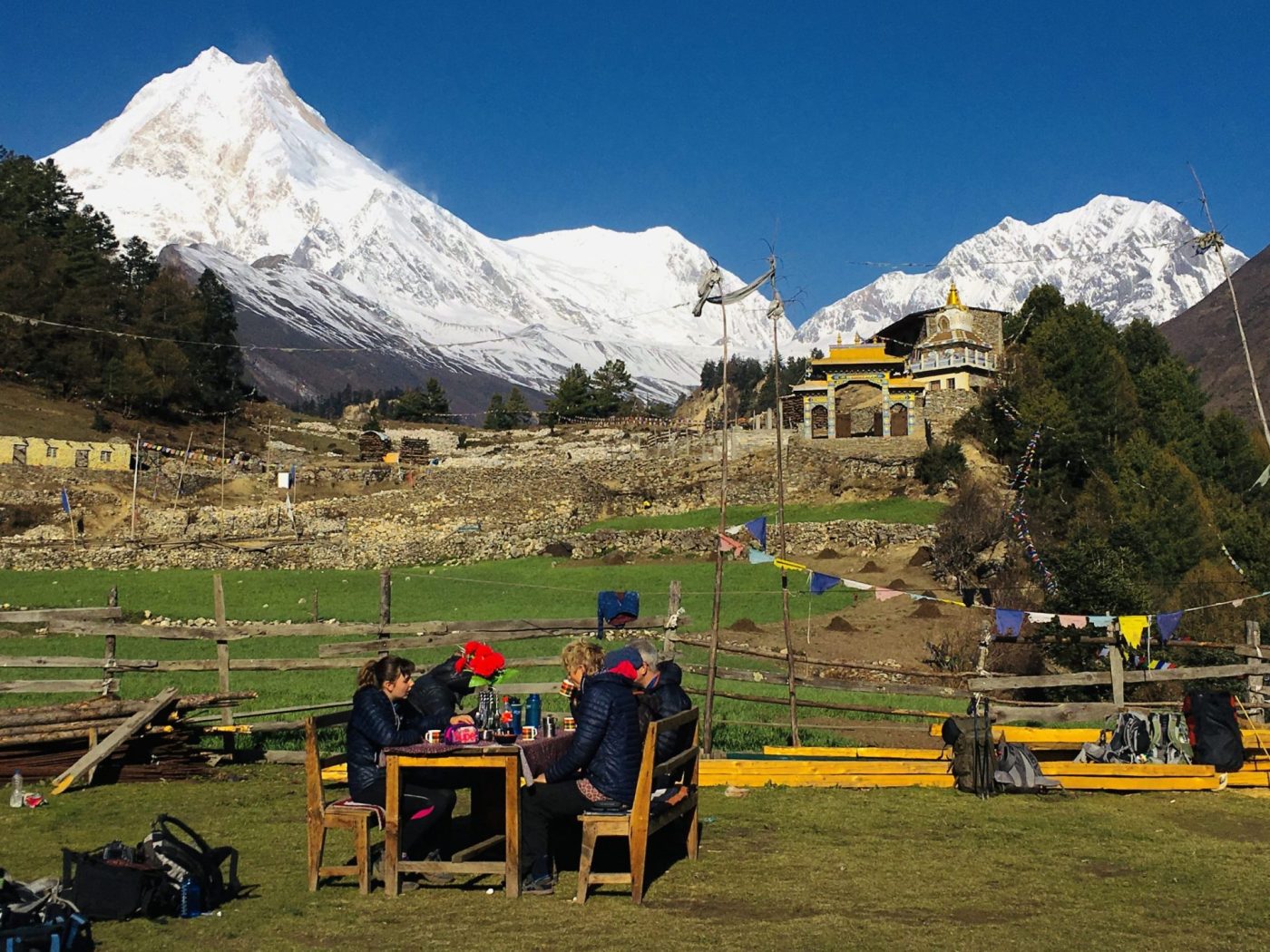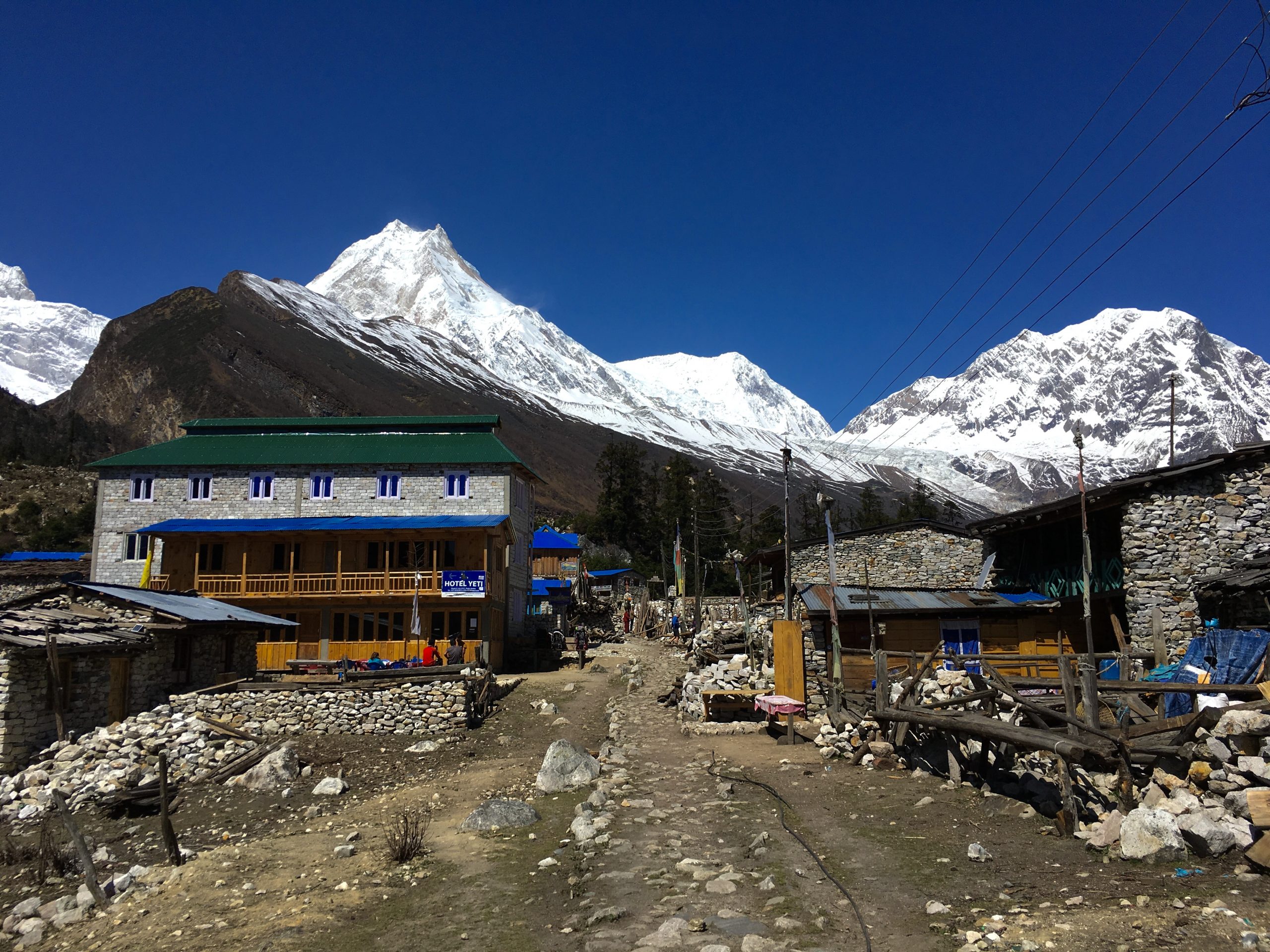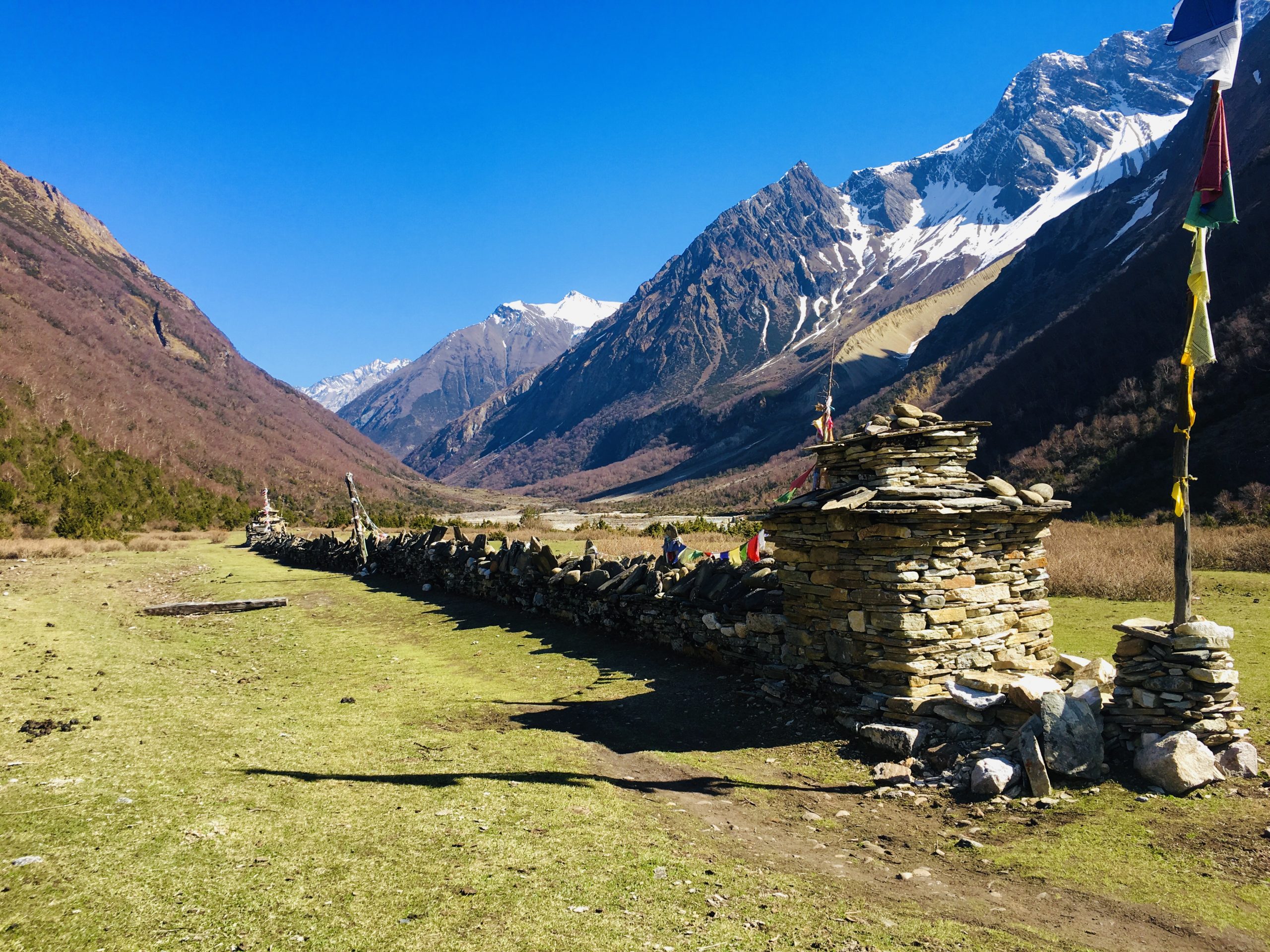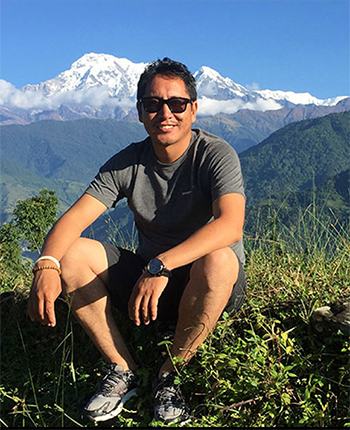


Manaslu Circuit Trek
...THE MOUNTAIN OF THE SPIRIT..- Trip Style:
- Ways to Travel: Sightseeing, Drive & Trek,
- Activities: Trekking
- Group Size: 2-12
- High Altitude 5106 m.

Trip Overview
The Manaslu Circuit trek, a remote trek of cultural and topographical diversity, is known for its spectacular Himalayan views including Manaslu, 8156 m, the breathtaking beautiful Larke La Pass (5160 m), a mix of Gurung and Tibetan traditional villages and its beautiful Tibetan Buddhist monasteries (Gompas). The scenery provides all Nepal has to offer; you’ll trek from the subtropical jungle at lower elevations, through the Himalayan foothills to the high, cold and challenging crossing of the Larkya la above 5,100 meters/17,000 feet.
This is a physically moderate to challenging trek, so trekkers should be in cent physical condition.
Trip Highlights
- Starting From : Kathmandu – Arughat
- End at : Besisahar – Bandipur
- Duration : 16 Days
- Grade : Moderate – Difficult
- Max. Elevation : 5160m
- Activity : Trekking Adventure
- Culture : Rai, Gurung, Nupri
- Best Season : April to November
- Himalayan sights : Siringi Himal, Simnang Himal, Nadi Himal, Himal Chuli, Mt. Manaslu etc
Detailed Itinerary
-
Day 1 Arrival in Kathmandu (1.300 m) Hotel in Kathmandu
It is a panoramic thrill flying into Kathmandu on a clear day. The views of snow-capped mountain peaks sprawling down below you are almost ecstatic, beginning a whole chain of memorable experiences that stay with you for a long time. Upon your arrival at Kathmandu, our representative will greet you at airport and escort you to your hotel. At the hotel you will be briefed about your daily activities. Depending on your arrival time, we can organize some exploring in the afternoon to introduce you to this amazing place and its unique ancient-modern mix. Tonight you will be staying near the Holy Boudhanath Stupa.
The Buddhists shrine of Boudhanath is one of the largest Stupas in the world and one of the holiest Buddhist pilgrimage plus a tourist destination in Kathmandu. It stands with four pairs of eyes in the four cardinal directions keeping watch for righteous behavior and human prosperity. Boudhanath is part of the shared history of Nepal and Tibet, with Tibet having held ruling privileges over the site until the last century. It is built on an octagonal base inset with prayer wheels and houses of Lamas or Buddhist priest, monasteries and shops ring the stupa. The area of Boudhanath is also famous for over 50 Tibetan Gompas or monasteries.
-
Day 2 Sightseeing in Kathmandu and Mt. Everest Flight [1 Hour] (Optional) Hotel in Kathmandu
Kathmandu, being a historical and cultural heart of Nepal, is a popular destination for tourists, trekkers and adventure seekers. The city presents a wonderful mixture of Hinduism, Tibetan Buddhism and Western influence in the Valley. The ancient cities Kathmandu, Patan and Bhaktapur are the major attractions, with their evocative city squares and represent an epitome of harmony in urban design, elegant architecture and refined culture.
Today we have an option of early morning mountain flight before breakfast – this flight is a truly spectacular 1-hour flight along the Himalayan Range to unforgettable Mount Everest and back!
After a hotel breakfast we will explore the must see UNESCO sites of Kathmandu and its surroundings. The morning will spent with a sightseeing tour of the holy Hindus Temple of Pashupatinath, Patan Durbar Square and the holy Buddhist Stupa of Swayambhunath and Boudhanath.
Pashupatinath, which houses a sacred lingam, or the phallic symbol of Lord Shiva is one of the holiest temples in the Hindu religion and was first mention in 365 AD. The Aryaghat alongside Pashupatinath and on the banks of the Bagmati River is a famous funeral site for the Hindus. It is such an important pilgrimage site that any Hindu should visit it once in their life and there is a constant stream of sadhus coming and going from Nepal and India. Non-Hindu visitors are only permitted to view the temple from the east bank of Bagmati River, as entrance into the temple is strictly forbidden to all non-Hindus.
Patan Durbar Square is one of the three ancient cities from which Kathmandu Valley was made up of – located at the south of Kathmandu city commonly known as the city of fine arts. According to legend, the founding of Patan dates back to Pre-Christian times. As opposed to the Malla Kingdoms of Kathmandu and Bhaktapur that were mainly influenced by the Hindu religion, Patan was for many years a major Buddhist city. It is believed that it was founded in the third century B.C. by the famous Buddhist emperor, Ashoka – who visited the town while on a pilgrimage from Northern India and built four stupas that enclosed the centre of the old town. This would make it the oldest continuing Buddhist town in the world.
Kathmandu Durbar Square was the palace of the medieval Kings who ruled over the then Kantipur Kingdom. Inside the Durbar Square complex, we will visit the residence and temple of the Living Goddess “Kumari”. Born to Buddhist parents, is a young girl who is considered sacred as long as she has not reached menstruation. Every year, the Kumari makes just 3 public appearances, during which she is carried through the streets by a large chariot. We will also see the Kasthamandap, the impressive resting place from which the name “Kathmandu” is said to have come and made from a single tree.
Swayambhunath meaning the “The self-existent” is said to be 2000 years old and is one of Nepal’s most important Buddhist sanctuaries located on a hill top. It is popularly known as ‘Monkey Temple’ as the area owing to the large number of monkey population residing in the area. The oldest inscription discovered dates back to the 5th century and refers to the founding of a monastery. The whole hill is a mosaic of small Chaityas (memorials) and temples and it is one of the only places that you can see the Stupa, Pagoda and Shikar style of temple. It is a sacred Buddhist place of worship, but it is also holy to Hindus and you can also find Hindu shrines here – a fine illustration of the religious tolerance found in Nepal.
-
Day 3 Drive from Kathmandu to Sotikhola [710m/2328 ft] 8 - 9 hours Tea House
We take a bus for the five-hour drive to the end of the road, either at Arughat or a bit farther depending on the road conditions, where we stay the overnight. Most trekkers start the trek in Arughat Bazaar. This pleasant market town is located on two sides of the Budhi Gandaki connected by an impressive pedestrian suspension bridge. From Arughat, we take a share jeep to Soti Khola.
-
Day 4 Soti Khola trek to Machhakhola (930 m) [6 Hrs] Tea House
Although the distance in the map is much shorter, do not be mistaken – walking this part is much slower, as the trail goes into a rough part of the Budhi Gandaki, goes up and down and with numerous rocky parts. In rainy periods there, are several waterfall crossings requiring shoes removal (or walking with sandals). Some parts of the trail are particularly narrow, suffer from landslides, and require extra care especially when mule convoys are around. At least one of the waterfalls that “decorate” the trail is tempting for washing. In Lading, on the way, there is a camping site. The village of Lapubeshi is spread on several hills along the trail, and it takes some walking time from the moment we enter the village until weget to the area where two lodges are located, at the northern part of the villages. Tropical vegetation adds its charm, together with the thrilling suspension bridges that start to be a regular attraction in this trek. Machhakhola is a pleasant village built on the slopes of the hill with several lodging options and a notable lodge development. This village can definitely be a convenient stopping place for the night.
-
Day 5 Machhakhola trek to Jagat (1.440 m) [6 Hrs] Tea House
After following the narrow trails of more vicissitudes there is a small trailside hot spring, then the route reaches Tatopani (930 m) meaning hot water. During the rainy season, the sound of roaring landslides may echo in the valley, raising some worries considering the location of Tatopani right at the bottom of the huge cliff. An hour + walk take us up to Doban (1.070 m), a small village with a basic lodging option (Himalayan Hotel & Lodge. In Yaru Phat, the Budhi Gandaki is quite impressive as it descends rapidly in nice cascades. The valley then opens in Yuru (1.330 m) to a point with several Bhattis. Jagat will impress us with its slate-paved streets giving it quite a tidy touch. In this part of the village, we will also find shops, a police post, the MCAP (Manaslu Conservation Area Permit) office and customs office that assess duty on goods bought from Tibet. Here we have to present our trekking permit and MCAP (Manaslu Conservation Area Permit) ticket, and will be able to learn about MCAP activities in the region. Jagat is a relatively central village with an elementary school where children from the nearby villages get their education.
-
Day 6 Jagat trek to Deng (1.860 m) [6 Hrs] Tea House
The trail from Jagat descends to the pleasant village of Salleri, and then to Setibas (1430m). Decrepit stone kani and several Mani walls indicate that the trek is now entering a region of Tibetan influence, although the people are still Gurung. We pass the small village of Ghate Khola with two water-operated mills and reach a police check post where we have to show our permits. Immediately after that, we board one of the longest suspension bridges of this trek, crossing the Budhi Gandaki following by a steep climb to Philim (1590m), a central village in the area. We then pass by Ekle Bhatti from where the Pines start to dot the landscape and the gorge of Chilung Khola joins the Budhi Gandaki. Near this point (About an hour walk from Ekle Bhatti), there is a branch in the trail. Note to visitors to Tsum Valley. Tsum Valley visitors will have a half a day trek from Philim to Lokpa. Continuing on the main trail, tropical atmosphere accompanies us as we continue up the Budhi Gandaki. In order to avoid some cliffs, the trail crosses the Budhi Gandaki to the eastern side and back on two dilapidated suspension bridges, giving us an impressive sense of suspense. A new one is currently replacing one of these bridges. After a bit more walk, we reach Deng (1860m).
-
Day 7 Deng trek to Namrung (2.630 m) [6 Hrs] Tea House
After a brief walk beyond Deng, we pass through the tiny village of Rana gaon (1980m) with some dramatic views of the Budhi Gandaki gorge. From the bridge, we climb a bit to join a trail from Bhi, then head west up the Budhi Gandaki valley. The trail also passes through forest and Mani where we turn towards a corner that to Ghap. Even though there is another route, we take the route through Prok village. Prok village has a viewpoint for a beautiful sight of Siringi Himal. We further cross the Budi Gandaki several times today and come across several gompas en route. The trail follows the river upstream through a dense forest. After crossing the river at an impressive spot where it thunders down a narrow gorge, the forest becomes less dense and the trail is fine again. The pleasant walk continues and after a last steep climb, we reach Namrung.Namrung feels touristic, although not so much as Deng. Namrung village is a good viewpoint for Siring and Ganesh Himal and from the village one can see Mt. Himal Chuli in the south.
-
Day 8 Namrung trek to Samagaon (3.530 m) [5 Hrs] Tea House
The trail from Namrung climbs steadily, passes through forests, and reaches Lihi. Lihi is a recommended base to visit Hinang Gompa and Himal Chuli range. The trail drops and crosses the side valley of Simnang Himal and Ganesh Himal always closes by. We further pass through Sho, Lho or Lhogaon and Shyala villages before reaching Samagaon. A large Gompa that includes a home for more than 150 children that get their education here dominates Lho. The top of the hill is a recommended viewpoint to first (and some would say best) view of Mount Manaslu. It is highly recommended to view Manaslu as it fades during sunset, but better during sunrise, when the morning glow shines on its top. Shyala is preferred for its snowy mountain scenery like Himal Chuli and Peak 29 (Nadi Chuli) to the left, Manaslu and large glaciers straight ahead, and other snow summits to the right, and at the far end stands Ganesh Himal, which is one the best in the trek. Shyala and Samagaon are good bases for a visit to Punggen Gompa. The trail from Shyala on crosses the slope that drains Punggen glacier and reaches Samagaon through a nice flat area, where we can at last view lovely Yaks grazing.
-
Day 9 Explore Punggen Gompa or Manaslu Base Camp (4.470 m) [5 Hrs] Tea House
Samagaon is a lovely village with houses aligned in rows along a small river and face nice courtyards. The fields are located on both sides of the village above its houses level. Lodges are located north of the village, and they are full of action especially during the Manaslu climbing expedition’s periods. The two climbing seasons are autumn and spring, with an advantage to autumn. In season, many expeditions try to reach the summit. In spite of the difficult weather, most climbers managed to reach the top, some of them without the use of oxygen bottles. Samagaon is the closest village to Manaslu Base Camp – the first station of the expeditions, and villagers are often calling to help carry stuff to and from the base camp, adding them a significant source of income. We spend the day at Samagaon for several reasons: acclimatization, enjoying the village, and a day trip to Manaslu Base Camp or Punggen Gompa.Punggen Gompa a monastery with great views of the glacier. It is named after Manaslu, Punggen meaning bracelet, a good description of the two peaks. It was destroyed a year after the first unsuccessful Japanese attempt to climb Manaslu.
-
Day 10 Samagaon trek to Samdo (3.860 m) [5 Hrs] Tea House
- The trail from Samagaon to Samdo goes north on the upper part of the Budhi Gandaki with another day of incredible mountain views, past craggy woods of Himalayan Birch. En route we pass the long Mani walls at Kermo Kharka, after which we spot the entrance chorten of Samdo high on a bluff. Just before entering, the villagepasses through the point where the Budhi Gandaki actually starts at the confluence of Larke Khola and the river coming from Samdo Glacier. Samdo is a tiny lovely village located just under the majestic Samdo peak (6.335 m) and the Samdo Glacier. There are two lodges here – “Yak Lodge” and “Tibetan Twins Lodge” named after the twin children of the family. We are at high and the wind can be chilling in the evenings, so tuck into the little teahouse for a cup of salt-butter tea to warm you up.
-
Day 11 Rest Day in Samdo Tea House
This is another day set aside for proper acclimatization in this wonderful spot below Manaslu and a day trip to the Tibetan Border. Samdo is at the junction of three valleys and we will see yak laden with timber heading east over the Lajyang La (5.089 m) to Rhee village in Tibet, a day walk away, returning with Chinese cigarettes and cans of Lhasa beer. We recommend a hike up the valley directly at the back of the Samdo village, heading towards one of the trade passes to Tibet for excellent views of Mt. Manaslu along with other Himalayan ranges including Simnang, Himalchuli, Ngadi, Larkya Peak, Cheo Himal and possibly Kang Guru behind the pass. Enroute to theses viewpoints, we pass many seasonal herding settlements called “Dokpas” meaning nomads and sight some beautiful mountain birds like the Lophophorus (the national bird of Nepal), Lammergeyer and Himalayan Griffin soaring high above us. The prayer flags strung up on a distant hill, sending messages out into the Himalayan make a good stopping point before returning to lively Samdo. Another option for today could be a trip to the Gya La (‘large pass’) to the north of Samdo, a more frequently used trading route to Tibet. However, this is a rather longer hike of whole dayand hence could be a little tiring.
-
Day 12 Samdo trek to Dharmasala (4.460 m) [4/5 Hrs] Tea House
The trail from Samdo continues on the old trade route towards Tibet, cross the Athahra Saya Khola and goes along the Larke bazaar, one of the trade markets that flourished years back. After about three hours of climbing past glaciers with increasingly awe-inspiring panoramas, until reaching the highest point before Larke La pass is Dharmasala where it is possible to construct a campsite and some structures. Dharamshala is a wide gradual mountain slope with campsite and a lodge called “Larke Rest House”. Here we will have lunch and gaze out at the views. We will really feel the altitude and the cold here, so enjoy a more leisurely afternoon and keep warm. We will have an early dinner in preparation for our pass crossing tomorrow.
-
Day 13 Dharamsala trek to Bhimtang (3.720 m) crossing Larkya La (5.160 m) [9 Hrs] Tea House
This is “the big day”, where you cross Larke Pass. An early start is necessary. Two hrs from Larke Rest House you reach a beautiful turquoise lake that reflects the surrounding snowy mountains. Just before Larke pass there are several small shallow lakes before the final climb to the prayer flags marking the first part of Larke pass. From the first part of the pass, we do not see “the other side”. You have to walk along a moraine to reach the western side of the pass where you can get a glimpse of the mountain scenery of the other side. The interesting Larke Pass is followed by a steep tiresome descend down through a slippery trail towards the moraine of Salpu Danda glacier. The trail then becomes gradual as it goes along the moraine and parallel to Bhimtang glacier towards Bhimtang. Pongkar Lake can be seen to the west, and a trail to the lake branches from the main trail about an hour before reaching Bimtang. Bimtang is a surprising spot located in an almost impossible place between Bimtang glacier and the slopes of Larke Himal range. Bimtang a great place to stay for its surrounding scenery is charming.
-
Day 14 Bimtang trek to Tilje (2.300 m) [6 Hrs] Tea House
The trail south of Bimtang is magical. The vegetation here is lush and colorful, and the trail crosses the foot of the Bimtang glacier through fantastic scenery. It climbs to a beautiful spot decorated with prayer flags, where awesome sights of mountains surround you, with Manaslu range in sight to the southeast. The trail then goes into a magical forest rich with firs. The village of Gowa (sometimes spelled “Gho”) stretches along the trail. It takes about 20 minutes from the moment you enter the village until we get to the lovely “Manaslu Hotel” on the other edge of the village. A nice 2 hours walk in a beautiful forest takes you to the lovely village of Tilje (2300m). Travelers choose to sleep here rather than in Gowabecause of it’s welcoming atmosphere in the village, with a few lodges, and rich with agricultural activity.
-
Day 15 Tilje trek to Dharapani and Drive to Beshisahar by Local Jeep [4-5 hrs] and Continue drive by private car to Kathmandu or Pokhara [6 Hrs] Tea House
We climb over a small ridge and enjoy the stone paved trail as it passes through a beautiful village. We then cross the Dudh Khola on a very long suspension bridge and climb up through a Chorten –shaped arch, pass a Mani wall and reach the Thonje village, which marks the official ending of the Manaslu trail. Another bridge takes you over the Marsyangdi River to Dharapani, where you join the Annapurna tourist highway. Then continue down to Jagat by checking at the ACAP check post and passing through Karte village, Tal village situated at the foot of a large waterfall and Chyamche or Chamje village. The Marsyangdi valley opens from here with its terrace fields and villages clung very high to the hillsides. Chamje is an atmospheric, “wild west” village of traditional-style teahouses, often packed with saddled local horses. From here, the road building is full on. However, before then one more steep descent through the woods, looking across the river to large waterfalls, leads us to the lovely cobbled village of Jagat, situated on a shelf, which juts into the precipitous Marsyangdi Valley.
During Besisahar to Kathmandu or Pokhara that offers an opportunity to enjoy both hill and mountain landscapes. After checking in to our hotel, we are free to spend the time in leisure or perhaps we catch up with some last minute shopping or explore any sights we missed during our first day in Kathmandu. In the evening, we get to enjoy a farewell dinner meant to celebrate our successful completion of ” Manaslu Circuit Trek” and plan our nest adventure in the wonderful country of Nepal.
-
Day 16 Drive to airport & Fly home. N/A
Today after the hotel breakfast, we can sit back and spend the morning leisurely; perhaps catch up on some last minute shopping.Later on, we will transfer you to airport in time for your flight home.
(3 hrs before flight departure time)
Inclusions & Details
- Airport pickups and drops
- Ground transportation in private van / Jeep
- One Nights Hotel in Kathmand and one Night Hotel in Bandipur with breakfast
- Thirteen Nights – Fourteen Days Full Board Trek
- One circle of meal
- Accommodation in Teahouommon room with twin sharing basis
- One Govt. Licensed Trekking Guide
- One porter for every two pax with maximum of 20 kg weight – All necessaries for Nepali staffs (All Meals, Accommodation, Transportation, Insurance, Equipment, Salary, etc.)
- Manaslu Restricted Area Permits, MCAP and ACAP Permits
- Ground transportation with private/local jeep to trek starting or ending point
- Comprehensive Travel Insurance covering trip cancellation Charge and Emergency Rescue
- Gear or Equipment you may need to Buy/Rent – Please ask for any advice to Bring/Buy/Rent
- Personal Expenses i.e. Mineral/boiled Water, Soft Drinks.
- Bar Bills, Extra Snacks i.e. Starter/Desert/Soup, Laundry, IST/STD calls, Postage, Entrance Fees and Photography Fees in Monasteries
- Extra charges that Teahouse owners may levy Attached Bathrooms, Hot-shower (if available), Charging of batteries etc.
- Local Donations if any
- Unforeseen expenses due to Flight Delays, Natural Calamities, Political Unrest or Fuel Shortage
- Lunch and Dinner in Kathmandu and Pokhara
- Services other than mentioned above
- Staff Tips
Date & Price
If you are looking for a group to join this trip please click the Fixed Departures tab for more information on departure dates, availability and price
For Queries & Reservations
Travelling with us is flexible, freedom and fun.
We deliver exceptional products at a very good price for you, but not at the cost of the environment or our social responsibilities “travel Responsibly”




 Trip HIghlights
Trip HIghlights
 Detailed Itinerary
Detailed Itinerary
 Inclusions & Details
Inclusions & Details
 Date & Price
Date & Price
 Trip Review
Trip Review
 Faqs
Faqs
 Travel Videos
Travel Videos
